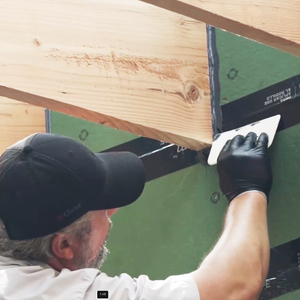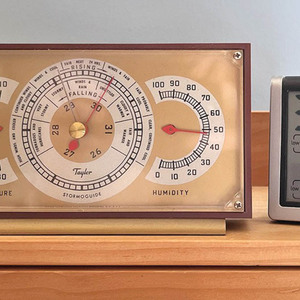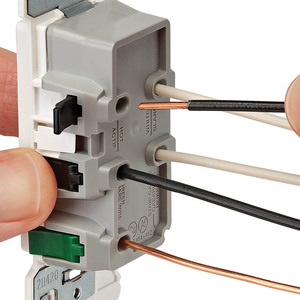I need to help wire a larger garage area 28×36. This is for a relative, one of those jobs that you sink in like quicksand, just trying to help. Some runs will be over 50 feet from the service panel/circuit box. None will be farther than 75 feet. Can I run 10 gauge wire from the service panel to a central box for multiple fixture runs, such as outlets, lights, etc? and then run 12 gauge to the fixtures. Or do I need to bite the bullet and wire in a subpanel or just run 10 gauge to everything? I’m a carpenter that wires only when forced. Trying to find the most economical and safe way to wire. Never wired runs this far. Nothing odd or heavy like three-phase or even 220V, just plain old 110V outlets, a few floures.& incandes. lights and two garage door openers. Will be running normal powertools/ compressors etc. House has 100 AMP service.
Anyone know why I am getting a consistent 95V reading on 110V outlets in this same house? My voltmeter seems fine, it checks other houses/currents properly. I’m no expert, but this seems weird.
Someone once said that there are no stupid questions only stupid cats, or something like that. Some people are really full of it. Thanks for any help.


















Replies
Well, I'm no electrician but I have about your same level of expertise. FIRST THING I would do is fix the 95v problem and to do that you need to determine whether its a service entrance problem (loose connection/corrosion) or main breaker problem. For the garage, I would definitely use something like a 60A subpanel.
"Anyone know why I am getting a consistent 95V reading on 110V outlets in this same house? My voltmeter seems fine, it checks other houses/currents properly. I'm no expert, but this seems weird."
First of all the nominal supply voltage is 120 VOLTS, NOT 110.
95 volts indicates a very serious problem. Go to the main pannel and measure the feeds. If you have anything less than 230 volts line to line or 115 either line to neutral then call the power company. If you have one line to neutral much higher than the other line to neutral call the power company IMMEDIATELY. That indicate that you have loose neutral and that is dangerous.
If you have nominal voltages at the pannel, but still only have 95 at the outlets then you have some bad connection and they must be located and repaired. Two main possibilities. They have AL wiring. In that case get an electrican that specialized in fixing it. The other common problem is back stab outlets. In those the ends of the wire are just pushed into the back of the outlets. They often fail.
"Will be running normal powertools/ compressors etc"
That leaves a wide range of equipment. Compressors are usually best on their own circuit and might even require 240. And what are the other "normal" power tools. Dust collectors, 3 hp cabinet saws?
The first thing that you need to do is determine the loads and the number of circuits. A sub-pannel is probably the best option.
Bill's statements are right. 95VAC... too low.
As for your approach to wiring the garage... is the garage attached or detached to the house that provides the feed?
Assuming it's attached:
1. Yes, you can run 10 gauge to a box, then split out to 12 gauge (with the assumption you're on a 15 or 20A breaker. Do NOT use a 30A breaker in this scenario.)
2. 75' is really not a very long run... voltage drop would be negligible. Because you said that you weren't using anything besides normal power tools, I think you could just run 12 gauge from the panel, and try to minimize the number of connections you have along the way. Voltage drop at connections is worse than what you get from the wire itself.
If your garage is detached, you're better look through the archives as this issue has been discussed before. I'd strongly advise against you doing this yourself unless you are pretty familiar with the NEC (or have an electrician as a soon to be ex-friend). You'll most likely need a subpanel in the garage (w/ neutral and ground separated), ground rods for this subpanel tied back to the house panel, etc. Again, I have the feeling you're not up for this type of "fun."
Instead of running several wires from the main to the garage and laundry I plan to run one wire to a sub panel. Not only will it be easier to to wire the area but if a breaker blows while I am running the table saw or something I don't have as far to run to set the thing.
What's so hard about installing it? If you get permits and have it inspected you'll know if you followed code.
Steve
Steve,
Nothing's really hard about doing a subpanel yourself. It's easy. And then again, so are virtually all other construction projects... IF you know what you're doing.
If you're familiar with code, and have a competent electrical inspector who reviews your plans beforehand, and your completed work... it really isn't a difficult job.
I just fear for those who rely on "big box experts" to tell them how to do the job. Like the time I had to tell the salesperson that SEU cable is not for direct burial. He swore up and down it was... "U is for underground" he kept spouting... and had I not known any better I would have been putting SEU in a trench to go out to my detached garage.
Needless to say, if you pull a permit and pass those types of details (wire type, size, method of installation, etc) past the inspector BEFORE doing the work... you're right, it can be an easy job.
Ralph, some references:
(DIL retired from Fluke, so is a favorite electrical test site)
http://www.fluke.com/application_notes/electricalpower/b0294c.pdf
Has a good short description on harmonics and meter indications.
http://www.fluke.com/Application_Notes/Multimeters/1260898.pdf
A basic tutorial on DMM operation and types.
http://www.fluke.com/application_notes/electricalpower/b0302c.pdf
Excellent basic tutorial on HVAC system tests (HVAC comes up often on breaktime)
Tried to find the GDT-190A with any technical data, no luck, even the GB catalog in IHS has only the index, maybe their full catalog does have a technical description of response type and if some ranges clip signals.
BTW, the $6.99 (when on sale, a BEST BUY??) Harbour freight DMM reads 120 VAC on all in-range settings at my house @ 2.3%THD voltage per fluke 123A.
Thanks for the links and all the help. I am interested in learning more about wiring and related fields.
Like others say, 95V bad, even 110V BAD.
What is the model number of the meter you are using? There are an awful lot of meters (especially cheap digital types) that read strange numbers if there are harmonics on the power lines. Even a great meter like a Fluke 77 (it measures average voltage and internally multiplies by 1.1 to get rms) does not read true rms, and can read anywhere between 100 and 140V on a true 120 VRMS line depending on the actual waveform.
Old EE saying -- When in doubt, use a 'scope.
Ralph; At risk of sounding smartr than i am, I think you better have a Real electrician figure out the low voltage. The only times I have seen that problem it was AL wiring, which is probly best left alone by carpenters. If the Electrician gets along well with the relatives, then ask if they would at least help with the layout of the new garage wiring. It won't cost much more to get it right the first time, and it will give many years of trouble free service. I had to have an electrician of record on my own remodel, and he probably saved my butt from lots of foolishness, money very well spent in my opinion!!!
Dan
I think you may be right Junkhound, my meter may be ther problem. It is not a very expensive one, as I said, I am a carpenter. I have $500 saws, drills, compressors and the like, but I couldn't afford to spend much on electrical tools. I just don't use them much. I have had this meter for several years. I can't even remember where I got it. I bought it when I was doing DC work on Harleys. It has served me well for that purpose. The model #is GDT-190A made by GB. It is a digital one with only two settings for AC. One labeled 750V reads 119V the other labeled 200V reads the 94.2-95.5 reading. As for the house, I have checked all the connections, there is no AL wiring, and checked the readings at the main feed lines. all are consistent with the above readings.
I also found out that the electric Company has recently upgraded the feed lines and transformer to the house to support a 200AMP service. BUT the lines coming down the side of the house and into the meter and thereafter the main circuit box have not been upgraded. Does this matter?
SOLUTION: new multimeter is on my shopping list. A profesional electrician as at least a consultant is on his. I think that he will be upgrading to 200Amp service and a subpanel.
Thanks
I did once look at my power line with a scope. It looked like a sine wave, except for a tiny little glitch at around 45 to 60 degrees (and the same thing the other way 180 degrees later). This thing looked like a little sawtooth, jumping down, and rising back up to join the sine. Peak to peak it was no more than a few dozen to a few hundred millivolts. My guess is it might be a transient from flourescent lights, or from a triac dimmer kicking in. I found it by enlarging the waveform a lot, and then following along it. I doubt that it was big enough to confuse a meter.
As for voltage, the DWP standard is that they're supposed to give you the nominal voltage plus or minus 5% as measured at the service entrance. By that standard, 114 to 126 would be OK.
-- J.S.
I worked on several systems detect zero crossings and either counted them for time keeping purposes or used it to compute firing angles on triacs for variable speed dc motors.
I never noticed an appriable distortion on the AC lines.
BTW, a few months ago I did a search on supply voltages for some reason that I don't remember now.
Anyway I can across a report of how they are Euro-izing the European power. I don't remember the exact number but some countries had 230 as the standard, some 235, some 240 and each with different tolerances. Basically what they did is just define a new range that would include all of the existing conditions.
They also listed the range for US voltages. I don't remember, what they where, there was a foot note that excluded CA. It said that they lower the lower range a few volts. I think that it was an attempt to save some power.
John,
I agree, most residential lines are so close to pure sine that only a harmonic meter or "calibrated eyeball" can tell the difference (mostly in a triangualization of the wave rather than dicontinuities). Where I have seen big differences are at the end or rural lines post harvest where 70% of the loads (overloads?)are fans for crop drying and on office buildings with large computer loads. We had an office building that converted to newer computers (worse harmonics than previously, due to internal design of the power supplies). The 3rd and 9th harmonics burnt out a 45 kVA delta-wye transformer. (the triplett harmonics "run around" in short circuit in the primary and do the overheating).
European standards were mentioned. Unlike the US, there are harmonic requirements on all new load equipment in Europe. January 1, 2001, EN61000-3-2 (Harmonics) and EN61000-3-3 (Flicker) become mandatory in the EU for load equipment.
The US grid is stiff enough (low impedance) to not bother as of yet.
I am surprised that you have distortion caused by fan motors.
I am not really familar with this area, but I understand that there has been some problems with electronic ballast in large office buildings. The 3 or 5th harmonics don't cancel on the neutral and there have been overheating problems.
Bill - in regards to your overheating comment - one of the funniest quotes heard in this vein was that one way you can tell a building with 3 phase has high harmonics is if "the white wire is brown" .
a) 100 amp service is undesirable.
b) A subpanel is desirable. Probably a 60 amp unit, but
this is not good with 100 amp main panel. You'd have to
drop to a 40 amp and that would be marginal with a compressor.
You need 8/3 feed for 40 amp and 6/3 for 60.
c) As other have said, the 95 volt issue is very dangerous.
Get it fixed now, before any other work is attempted.
Do not do this yourself. There is a serious liability
issue here. You do not want your relative's house to
burn down. This IS a possibility here. A 25 volt drop
means potentially 2,500 watts are being dissipated someplace
in your wiring. That means a fire. Fix it NOW. If it
were my house, I'd turn off the main immediately and not
turn it on until it was fixed. It's THAT serious.
d) Absolutely without a doubt get a licensed electrician
as a consultant. He can tell you what needs to be in
conduit, what type of wire, grounding and bonding, etc.
You can do the grunt work and the inspector will tell you
if its wrong, but you do not want to have 100 feet of
6/3 run and stapled only to have the inspector say
"rip it out and use conduit".
100 amps service is OK in most houses.
40 amps is adequate for a garage, unless you're running a really big compressor. I didn't see anything listed that would draw much current.
I would check the input voltage at the panel before doing anything else at all. Possibly the service to the house is low due to power line factors. The power company will have to correct the problem. Otherwise there could be a major fault in the house.
Junkhound:
There will be no harmonics present in a residential service. A fluke 77 will read line voltage with incredible accuracy. The only time it would be inaccurate is on waveforms and frequencies that are not present on residential power lines. It is calibrated on AC using 60 Hz sinusoidal waveforms.
I always heard old the EE saying was "When in doubt VOM it." Course that was before DVM days.
Edited 5/18/2002 10:35:39 AM ET by MARKH128
Probably discussion for another time & place, but I've seen a 77 (Not a true rms meter) read well below a Fluke 123 scopemeter that read 120Vac on rural lines at end of long feeders. Have also seen a 77 read 140 Vac on aircraft when the scopemeter read 115 Vac.
I bet the aircraft was 400 Hz, modified sine wave, and the rural lines may not have had a true sinusoidal waveform. But true RMS is not normally needed for residential line voltage.
Thank you all for the advice. I have found that I can depend on most everyone in this forum for good infromation. I will check all the areas listed and keep you posted. I think that with this info, I can help convince him to make the big decision of having a Pro either consult or just outright do a 200 AMP upgrade and go with a subpanel. He just needs some info to make a good decision. Thanks.
In the spirit of the original post, and on the subject of subpanel feeders, Rex Cauldwell (Wiring A House, page 70) comments that "a subpanel requires a four-conductor cable (SE, type R)", and goes on to speculate that it may be hard to find. I can't find a reference to this particular cable (type R?) anywhere in the NEC. Is it a requirement that this type be used for subpanels? Why not use NM three-conductor plus ground of suitable size? I am, of course, talking about indoor applications, and the author seems to be describing the same type of application. Can anyone clarify this?
SE type R is also called SER
See http://www.southwire.com
As far as I can tell SEU is 2 wire plus ground entrance cable and SER is 3 wire plus ground for sub-pannel use.
One of the advantage over NM is that is can be used with the 75 or 90 degree ratings if the breakers and pannels have such ratings. While the NM is limited to 60 degree ratings.
NM, at least from Southwire only goes up to #2 while SER starts at #8 and goes upto 4/0
SER is aluminum conductors. NM is copper.
Make sure you use anti-oxidant goop with aluminum.
Copper is more expensive and harder to bend in heavy
gauges. Aluminum is fine in this application, just
make sure it is the right gauge for the panel you will
use. May not find what you need at The Big Box. Go
to a real electrical distributor. If you're nice,
they may tell you the right stuff and sell it to you.
They generally don't like to give advice because of the
liability involved. Guess the Big Box doesn't care about
the misinformation they deliver.
Bob
"SER is aluminum conductors."
That might be the more commonly available, but not all SER is aluminum.
Southwire only makes it in copper.
"Southwire Type SE, Style SER cable is constructed with XHHW-2 conductors. Copper conductors are annealed (soft) copper. Cable assembly plus fiberglass reinforcement tape are jacketed with a sunlight resistant grey polyvinyl chloride (PVC). Available as 3 conductor (2 insulated phase onductors, insulated neutral) or 4 conductor (2 insulated phase conductors, insulated neutral, bare equipment ground)."